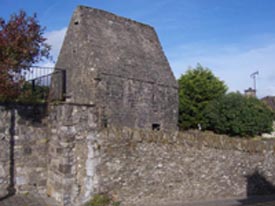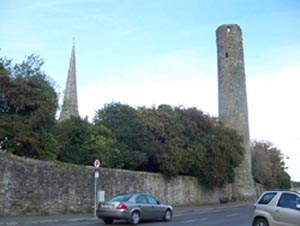The
town of Kells  is famous for the monastic settlement founded there around 554 by
Saint Columba (Saint Columcille.
7 Dec 521 - 9 June 597) is ) and the Book of Kells, brought to the
monastery in 803 when the Iona Monastery in the Scottish western
Isles was attacked and burnt by Vikings, The Book of Kells is now
on display in Trinity College
Dublin.
is famous for the monastic settlement founded there around 554 by
Saint Columba (Saint Columcille.
7 Dec 521 - 9 June 597) is ) and the Book of Kells, brought to the
monastery in 803 when the Iona Monastery in the Scottish western
Isles was attacked and burnt by Vikings, The Book of Kells is now
on display in Trinity College
Dublin.
The
remains of the monastery, including a substantial round tower is perched almost on top of one of the higher
hills in Co Meath, with commanding views of the surrounding countryside.
Considering that many other hills in Meath less imposing than that
at Kells were utilized in the pre-Christian Druidic culture, therefore
it would seem highly likely that the monastery at Kells now occupies
what was once a centre early Celtic worship.
substantial round tower is perched almost on top of one of the higher
hills in Co Meath, with commanding views of the surrounding countryside.
Considering that many other hills in Meath less imposing than that
at Kells were utilized in the pre-Christian Druidic culture, therefore
it would seem highly likely that the monastery at Kells now occupies
what was once a centre early Celtic worship.
Situated close to the monastery is Saint
Columcille 's House (pictured above) which is said to have been
built in the 10th century to house the relics of Saint Columcille,
famed for founding the Monastery on Iona (Western Scottish Isles)
and his dispute with Saint Finnian over a pilaster, probably the
first copyright dispute in Ireland which led ultimately to The
Battle of Culdemmena (The Battle of the Books). Saint Columcille
's House is built in the style of an oratory of the period, rectangular
in shape the roof is barrel vaulted with three small chambers in
the roof space. The building once housed a relic known as Saint
Columcille 's bed this was a stone six foot long and one foot thick,
which was stolen some some in the 20th century.
Local legends tell of an underground passage
between Saint Columcille 's House and Saint Columba's Church, this
is supported by both The Annals
of the Four Masters and the Down Survey carried out in the 17th
century. The wall surrounding Saint Columcille 's House was built
in 1836.
In 1076 Murrough MacFlann, claimant to the
high kingship was murdered in the round tower of Kells Monastery.
(Note: Have been unable to verify This.)
|